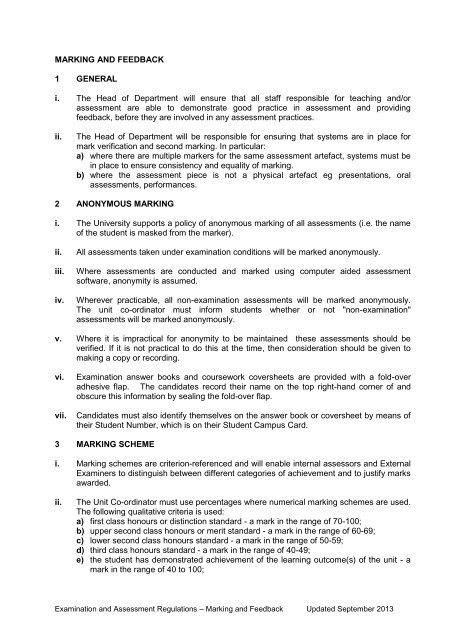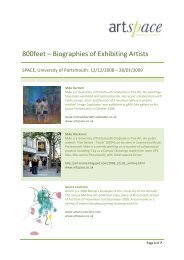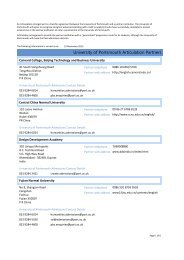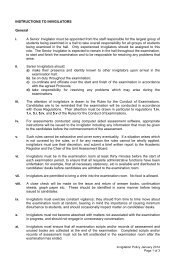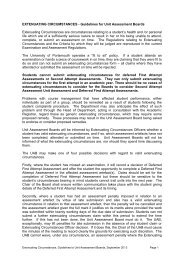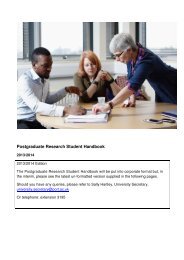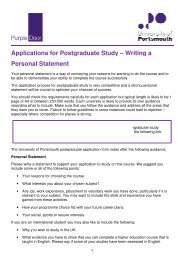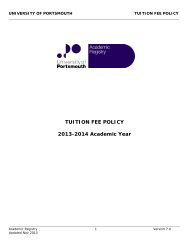MARKING AND FEEDBACK 1 GENERAL i. The Head of Department ...
MARKING AND FEEDBACK 1 GENERAL i. The Head of Department ...
MARKING AND FEEDBACK 1 GENERAL i. The Head of Department ...
Create successful ePaper yourself
Turn your PDF publications into a flip-book with our unique Google optimized e-Paper software.
<strong>MARKING</strong> <strong>AND</strong> <strong>FEEDBACK</strong><br />
1 <strong>GENERAL</strong><br />
i. <strong>The</strong> <strong>Head</strong> <strong>of</strong> <strong>Department</strong> will ensure that all staff responsible for teaching and/or<br />
assessment are able to demonstrate good practice in assessment and providing<br />
feedback, before they are involved in any assessment practices.<br />
ii.<br />
<strong>The</strong> <strong>Head</strong> <strong>of</strong> <strong>Department</strong> will be responsible for ensuring that systems are in place for<br />
mark verification and second marking. In particular:<br />
a) where there are multiple markers for the same assessment artefact, systems must be<br />
in place to ensure consistency and equality <strong>of</strong> marking.<br />
b) where the assessment piece is not a physical artefact eg presentations, oral<br />
assessments, performances.<br />
2 ANONYMOUS <strong>MARKING</strong><br />
i. <strong>The</strong> University supports a policy <strong>of</strong> anonymous marking <strong>of</strong> all assessments (i.e. the name<br />
<strong>of</strong> the student is masked from the marker).<br />
ii.<br />
iii.<br />
iv.<br />
All assessments taken under examination conditions will be marked anonymously.<br />
Where assessments are conducted and marked using computer aided assessment<br />
s<strong>of</strong>tware, anonymity is assumed.<br />
Wherever practicable, all non-examination assessments will be marked anonymously.<br />
<strong>The</strong> unit co-ordinator must inform students whether or not "non-examination"<br />
assessments will be marked anonymously.<br />
v. Where it is impractical for anonymity to be maintained these assessments should be<br />
verified. If it is not practical to do this at the time, then consideration should be given to<br />
making a copy or recording.<br />
vi.<br />
vii.<br />
Examination answer books and coursework coversheets are provided with a fold-over<br />
adhesive flap. <strong>The</strong> candidates record their name on the top right-hand corner <strong>of</strong> and<br />
obscure this information by sealing the fold-over flap.<br />
Candidates must also identify themselves on the answer book or coversheet by means <strong>of</strong><br />
their Student Number, which is on their Student Campus Card.<br />
3 <strong>MARKING</strong> SCHEME<br />
i. Marking schemes are criterion-referenced and will enable internal assessors and External<br />
Examiners to distinguish between different categories <strong>of</strong> achievement and to justify marks<br />
awarded.<br />
ii.<br />
<strong>The</strong> Unit Co-ordinator must use percentages where numerical marking schemes are used.<br />
<strong>The</strong> following qualitative criteria is used:<br />
a) first class honours or distinction standard - a mark in the range <strong>of</strong> 70-100;<br />
b) upper second class honours or merit standard - a mark in the range <strong>of</strong> 60-69;<br />
c) lower second class honours standard - a mark in the range <strong>of</strong> 50-59;<br />
d) third class honours standard - a mark in the range <strong>of</strong> 40-49;<br />
e) the student has demonstrated achievement <strong>of</strong> the learning outcome(s) <strong>of</strong> the unit - a<br />
mark in the range <strong>of</strong> 40 to 100;<br />
Examination and Assessment Regulations – Marking and Feedback Updated September 2013
f) the student has not demonstrated achievement <strong>of</strong> the outcome(s) <strong>of</strong> the unit - a mark<br />
in the range 0 to 39.<br />
iii.<br />
<strong>The</strong> University does not require pass standards or thresholds <strong>of</strong> achievement in particular<br />
components <strong>of</strong> assessment. Any variation to this regulation must:<br />
a) have the specific approval <strong>of</strong> Academic Policy Committee acting on the authority <strong>of</strong><br />
Academic Council;<br />
b) be recorded on the approved unit description;<br />
c) state clearly to which groups <strong>of</strong> students it shall apply.<br />
4 VERIFICATION OF MARKS<br />
i. All assessed work is subject to verification or double blind marking as follows:<br />
Units 30 credits or less<br />
If a unit is assessed by a single element with a single marker or if it is an assessment<br />
where it has been impractical for anonymity to be maintained, all assessments will be<br />
subject to verification. Otherwise, 10% <strong>of</strong> ALL assessments, with a minimum <strong>of</strong> 6 pieces<br />
and a maximum <strong>of</strong> 20 pieces, will be subject to verification. Verification means that a<br />
second member <strong>of</strong> staff scans the assessments to ascertain that the marks for the unit are<br />
broadly appropriate and have been fairly arrived at as described within these regulations.<br />
<strong>The</strong> sample must include work covering a full range <strong>of</strong> marks. If significant discrepancies<br />
arise, then the <strong>Head</strong> <strong>of</strong> <strong>Department</strong> may require all assessed work to be reviewed or<br />
moderated.<br />
Units greater than 30 credits<br />
All the assessed work must be "double blind" marked. This means that the two markers<br />
must mark the work without having sight <strong>of</strong> the mark awarded by the other marker. <strong>The</strong><br />
markers must then determine an agreed mark and agree both the form and content <strong>of</strong> the<br />
feedback. If the two markers significantly disagree and the differences cannot be resolved<br />
by discussion, then the <strong>Head</strong> <strong>of</strong> <strong>Department</strong> must nominate a third marker to review the<br />
work, unaware <strong>of</strong> the previous marks. <strong>The</strong> final mark awarded should then be derived by<br />
discussion between all three markers.<br />
ii.<br />
If, after verification or double blind marking, an agreed final mark can still not be awarded<br />
then the assessment must be referred to the Subject External Examiner for an opinion.<br />
<strong>The</strong> Subject External Examiner will not determine the final mark but will report to the Unit<br />
Assessment Board where the final mark will be determined.<br />
5 <strong>FEEDBACK</strong><br />
i. Except as provided within these regulations, the Unit Co-ordinator will be responsible for<br />
ensuring students are provided with feedback on all assessed work. <strong>The</strong> <strong>Head</strong> <strong>of</strong><br />
<strong>Department</strong> will monitor provision <strong>of</strong> feedback.<br />
ii.<br />
iii.<br />
Feedback will be provided for all forms <strong>of</strong> assessment, including examinations. It should<br />
provide an indication <strong>of</strong> the extent to which the work has met the assessment criteria and<br />
intended learning outcomes. <strong>The</strong> minimum requirements for summative feedback are:<br />
Major strengths <strong>of</strong> the work.<br />
Ways in which the mark could have been improved<br />
Original mark and any penalties that have been applied (where appropriate).<br />
<strong>The</strong> precise nature <strong>of</strong> the feedback will vary according to departmental procedures and<br />
custom and practice in the subject area. However, feedback will be normally be typed. If<br />
Examination and Assessment Regulations – Marking and Feedback Updated September 2013
oral feedback is used to supplement the written feedback, it may be delivered to<br />
individuals or to groups <strong>of</strong> students. Feedback on examinations and coursework may be<br />
written onto a pr<strong>of</strong>orma, a coversheet or directly onto the piece <strong>of</strong> work. <strong>The</strong> procedures<br />
adopted should not prejudice marking where the first mark is concealed from subsequent<br />
markers ("double blind marking").<br />
iv.<br />
<strong>The</strong> Unit Co-ordinator will make feedback available within twenty working days <strong>of</strong> the<br />
submission deadline or the date <strong>of</strong> the examination except for distance learning, where<br />
feedback will be made available within twenty-five working days.<br />
v. If feedback is unexpectedly delayed, the Unit Co-ordinator must inform students <strong>of</strong> the<br />
reason(s) and the date on which they will receive the feedback. This information must<br />
also be reported to the <strong>Head</strong> <strong>of</strong> <strong>Department</strong> and the Unit Assessment Board.<br />
vi.<br />
vii.<br />
<strong>The</strong> mark or grade provided to a student as part <strong>of</strong> the assessment feedback is a<br />
provisional mark subject to change and/or moderation until it is finally determined by the<br />
Unit Assessment Board.<br />
A student who submits work after the published submission date forfeits the right to<br />
feedback on that work, unless there were valid extenuating circumstances.<br />
6 RETURN OF ASSESSED WORK<br />
i. <strong>The</strong> <strong>Head</strong> <strong>of</strong> <strong>Department</strong> must make provision for systems to ensure that the return <strong>of</strong><br />
assessments to students is timely and secure.<br />
ii.<br />
iii.<br />
iv.<br />
Unit Co-ordinators must ensure that work for their unit is returned in a timely fashion and is<br />
either accompanied by feedback or feedback has been provided by alternative means.<br />
Unit Co-ordinators must ensure that a sample <strong>of</strong> work is either retained or photocopied so<br />
that it is available for scrutiny by the Subject External Examiner. In the former case, the<br />
retention <strong>of</strong> work must not prejudice the return <strong>of</strong> feedback.<br />
Students’ work must not be left unattended for collection. Work may be returned in a<br />
timetabled or non-timetabled session or it may be appropriate for students to collect the<br />
work from a central collection point in the home department <strong>of</strong> the Unit Coordinator.<br />
v. Where a student is unable to collect the assessment in person for a legitimate reason, a<br />
request can be made for either the assessment feedback sheet to be posted to the<br />
student or the student may identify in writing to the University a named third person to<br />
collect their work. This person must produce a form <strong>of</strong> identification to establish that they<br />
are the student’s proxy.<br />
vi.<br />
Students must be informed that there will be a time limit for collecting their work, after<br />
which it will be confidentially destroyed. <strong>The</strong> work should be held long enough to allow<br />
students a reasonable opportunity to reclaim it. For guidance on retention periods for<br />
assessed work, please see the University's Retention Policy.<br />
Useful links<br />
Retention Policy<br />
Academic Appeals<br />
Grade Criteria – Levels 4-8<br />
Current Definitive List <strong>of</strong> Approved Variations and Exemptions from the University<br />
Assessment Regulations and Policies<br />
Examination and Assessment Regulations – Marking and Feedback Updated September 2013


